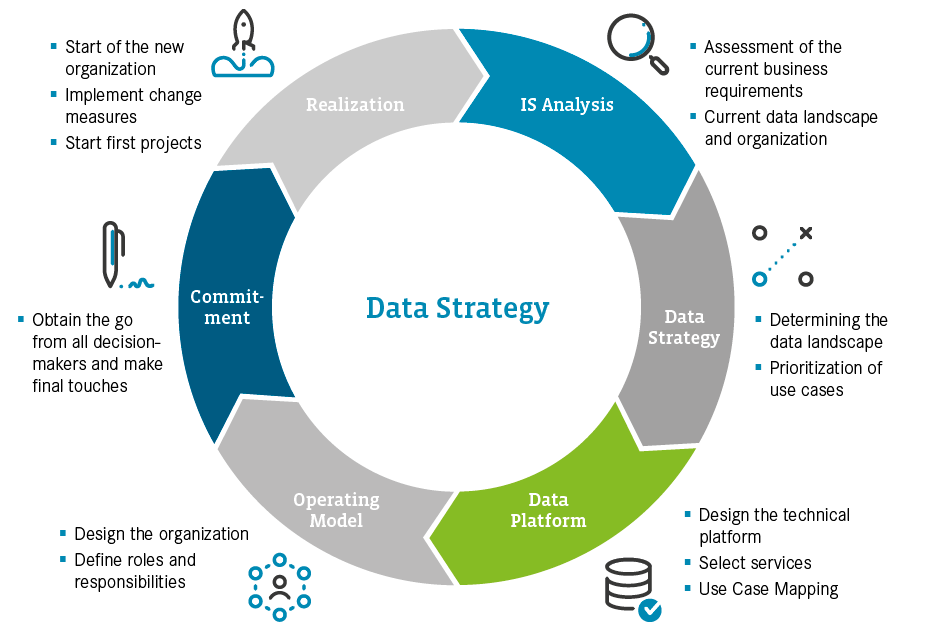Artificial intelligence: Many companies want to take advantage of this new trend. Especially but not only, AI-based application cases require the right data basis. A comprehensive data strategy also clarifies other questions related to processes or responsibilities. Such a strategy is fairly easy to develop and implement if you use the right approach.
Sabrina has a great idea for a data-driven use case that is supposed to be implemented with AI. At first glance, it looks like the required data is already available. She starts with the initial analysis - written in Python on her PC.
Now she wants to share the results with her colleagues and use larger data volumes for the AI model. Of course, she could also select a cloud provider and automatically upload the data to the provider's cloud. But the key success component is missing, namely the integration into the target system - a business app that is used across the different teams. Sabrina is not familiar with the direction of the digital road map, and there are no designated contact persons for architecture, compliance, operations or accounting. Ultimately, Sabrina becomes overwhelmed as the situation becomes too complicated. And so she gives up.
Combining business objectives with IT
This example is typical, as according to the latest Experience Report on Artificial Intelligence, only half of use cases are actually used in operations. The biggest obstacles are a lack of high-quality data, as well as missing organizational processes and specialists.
This means that digitization initiatives must create the right environment for the way into a data-based future. A coordinated data strategy - the central element of this digital transformation - connects the company's business objectives with its organization, in particular the IT department and its focus areas. In this way, companies can develop the essential skills inside the organization and clarify responsibilities.
These problems must be solved
At first, some important questions must be answered. The company must define which business objectives it is pursuing, and how data can support this process. For example, a data analysis can be used to develop new sources of income or business models, or to simplify existing processes. Moreover, companies must define how data-based use cases can be developed on a continuous basis, and they must prioritize them.
Another important consideration is the decision about which platforms and tools should be used. This also includes a categorization of which tasks the company will look after in terms of implementation and operations, and which tasks will be outsourced to external service providers. Uniform standards and rules should be applied in this context.
The company must also define who will monitor compliance with the legal requirements and data security. Not least, this must also include a review of whether certain ethical thresholds must be observed for the requested use cases.
A data strategy to create additional momentum
Companies can develop a comprehensive data strategy to answer these questions. The strategy is used to sketch out the desired target status of the organization and the IT platform, and to designate a road map with the corresponding parameters. But: This is not a one-time project. Data strategies must be reviewed regularly, and they must be continually adapted as the situation changes.
A pragmatic approach using the CS Data Strategy Framework (see Figure 1) can be used to develop the data strategy and the Target Operating Model (TOM) for data. It integrates the data strategy into an existing digital strategy. This results in an interconnected solution that avoids the emergence of insular individual solutions.

How the CS Data Strategy Framework works
The CS Data Strategy Framework is used to define an objective and concrete measures for its implementation in the context of the business strategy, whereby the latter is derived from the business requirements. On the basis of the desired use cases, the requirements for data provision, processing and use are used to develop the concept of an appropriate data infrastructure. This is followed by the development of the required structures and processes for data management and data governance. Afterwards, the measures are implemented in a road map.
The use of such a framework should be preceded by a thorough analysis phase. It identifies the intended level of maturity and derives the required organizational skills. This status-quo analysis makes it possible to identify problem areas at an early stage, and it also be used to determine the kind of information that will be required for the next five phases (see Figure 2).
They include the development of the data strategy and the Target Operating Model with the help of the CS Data Strategy Framework, and the provision of a data platform. This is followed by the organizational phases Commitment (for the decision-makers) and Realization (including change management). Next is the development loop, which begins with the status quo analysis.

Added value for companies
Companies can achieve the following added values with the help of a data strategy:
- Faster decision-making through standardized generation and clear prioritization for the initiation and implementation of data-driven use cases
- Shorter project periods through clear responsibilities and regulated processes for the implementation and operation of data-driven use cases
- Immediately available and up-to-date technology and platform environment
- Lower risks and high compliance through defined parameters for the use of data
For example, by using the right data, one football club was able to increase season ticket sales. Other successful use cases demonstrate the value of a solid data strategy.
Added value for employees
Using the available data strategy, Sabrina can generate real added value for her AI use case. The designated contacts help her with clarifying the requirements, and with using the right cloud products and services. Even basic questions - such as questions about the architecture and compliance - can be clarified. Now she knows how to implement the use case on a content level. The general technical and organizational environment is set out by the framework, and it is clear how the use case must be integrated into the business application. The question of who will look after operations and under which conditions the use case will continue to be developed (or stopped) is also addressed and clarified. It means that Sabrina can go ahead with a sense of security and confidence.


